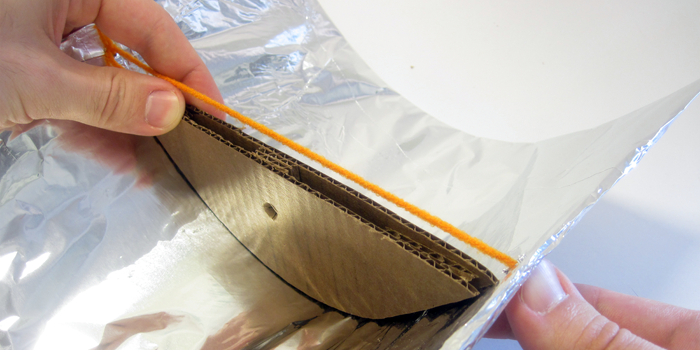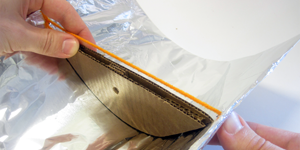Wi-Fi Science: Boost Your Wireless Network
If you have ever grumbled about poor Wi-Fi at your house, this pair of hands-on science projects is the perfect duo for summer tinkering. Learning more about Wi-Fi and experimenting with a DIY solution might make a big difference in your Wi-Fi signal strength! This is hands-on science that could reward industrious young engineers with a healthy dose of improved network speed. What does a parabola have to do with your Wi-Fi? Grab a protractor, your math skills, and some aluminum foil to find out!

Whether you are playing a game on a console system, streaming videos on a tablet, or scrolling a favorite app on your phone, having a solid Wi-Fi signal is probably really important in keeping you connected when you are at home. If you tend to use a lot of data when you are not home, maximizing your time on Wi-Fi may be even more important in terms of staying within your monthly limit. If your Wi-Fi works well, switching off of cellular and over to your home network may be no big deal. It your Wi-Fi doesn't work reliably, however, being forced to use your home network may be a real problem. It can be very frustrating when Wi-Fi cuts out in the middle of something you are doing, for example, and finding yourself unable to get certain content to load over Wi-Fi can put a serious crimp in your home Internet use.
Weak Wi-Fi
If you have home Wi-Fi issues, you are definitely not alone. Consider these two real-life examples:... I live in a fairly small house. The Wi-Fi router is set up at one end of the house. When I sit in the dining room, which is less than 30 feet away at the other end of the house, my Wi-Fi is either inaccessible or consistently drops. I first discovered this when I would sit at the table to play Clash of Clans and would get bumped out of my battles (over and over again) because the Wi-Fi would cut out.
... When I go to visit my relative, we always have a problem with the Wi-Fi. With four to five of us all logging in with different devices, the Wi-Fi goes down repeatedly. We reset it over and over, but it doesn't seem possible for all of us to use the Wi-Fi at the same time without crashing the network.
Both of these scenarios can be frustrating for people who are trying to use a home network and can't reliably stay connected or find the Wi-Fi sluggish.
If either of these scenarios is similar to something you have encountered, one of the following hands-on science projects might help uncover and explain Wi-Fi dead zones (or problem spots) in your house and/or help you boost your signal and improve your Wi-Fi experience.
- What Materials Can Block a Wi-Fi Signal?: this project may help you determine why parts of your house have more Wi-Fi issues than others. By investigating different materials and how they may block or weaken radio waves, you may be able to pinpoint items (or materials) in your house that stand between you and the Wi-Fi router and are causing connection problems or Wi-Fi slowdown.
- The Point of a Parabola: Focusing Signals for a Better Wireless Network: tackle a weak home Wi-Fi signal with a roll of aluminum foil and a protractor! Using ordinary household materials, build and test a parabolic reflector. Once the cardboard and aluminum foil device is assembled, attach it to the antenna of your router and experiment to find out the best angles to boost the signal through your house.
Science with Personal Impact
Together as back-to-back projects, this pair of computer science and technology projects might make a huge difference in your home Wi-Fi. By better understanding what may be causing interference in the Wi-Fi signal and by experimenting with a parabolic reflector, you could maximize the Wi-Fi signal in your house. By the end of this set of projects, you will know exactly where you want to sit for the best streaming, app-loading, game-playing, video-watching Wi-Fi experience.
Making Career Connections
Students interested in analyzing network signals, seeking ways to strengthen and safeguard networks, and other computer science networking challenges may be interested in learning more about science, technology, engineering and math careers like these:- Radio Frequency Engineer
- Computer Hardware Engineer
- Computer Systems Analyst
- Computer Network Architect
- Electrical Engineering Technician
See also: Unleash the Engineer in You: Tackle Everyday Problems with STEM Projects.
Categories:
You Might Also Enjoy These Related Posts:
- Plastics and Earth Day - Science Projects
- Arduino Science Projects and Physical Computing
- 10+ Robotics Projects with the BlueBot Kit
- 5 STEM Activities with Marshmallow Peeps
- March Madness Basketball Science Projects: Sports Science Experiments
- Women in STEM! More than 60 Scientists and Engineers for Women's History Month
- Explore Artificial Intelligence and Machine Learning with Student AI Projects
- 10 Reasons to Do the Rubber Band Car Engineering Challenge










